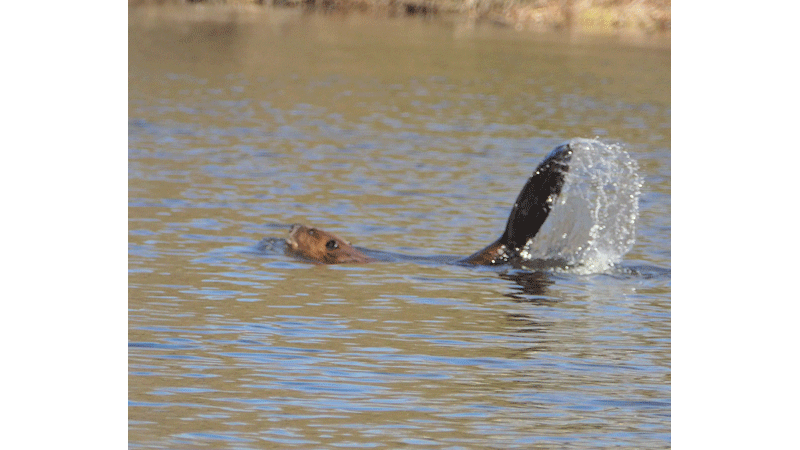Bon voyage, bowfin
Published 6:30 pm Tuesday, January 31, 2023

- Pictured is the beaver that was slapping the water and swimming at a high speed in Jacobs Cove near RiverGuard Jeff Turner during his Jan. 27-29 patrol on the Blackwater River above Burdette. (Photo submitted by Jeff Turner)
|
Getting your Trinity Audio player ready...
|
Spirit of Moonpie and I spent January the 27th through the 29th on the Blackwater above Burdette. The water was clear, 42 degrees and 5.68 on the Burdette USGS gauge. Air temps ranged from 25 to 58 degrees. That was a cold 25 that first night, I’m here to tell ya. I saw no water quality issues and picked up only about a half a bag of trash, which was great for that part of the river. However, it should not have been even that much given the fact I have been there four times in the past two months.
I had quite the strange beaver experience on this trip. I was in Jacobs Cove when this large beaver started swimming around the mouth of the cove and slapping its tail. This was going on at like one in the afternoon. Not only was the time of day a little odd, the beaver was swimming back and forth like a speed boat. I have seen a lot of beavers in my day, but never one swimming constantly this fast. It was unreal. Over and over the large, high-speed tree muncher crisscrossed the cove, slapping the water repeatedly. It even woke Moonpie up from the back of the boat. I finally went after it with the trolling motor and camera. The obviously very territorial beaver never stopped this behavior, even when I started the outboard to leave. I’m sure when it returned home, it told its spouse it had accomplished the mission and ran the human away!
The fishing on this trip was just OK. I caught a few catfish and one bowfin at the Stringwood curve. Once again, no bowfin in Jacobs Cove. Over 30 years of fishing for bowfin in that cove and I have never not caught bowfin there at this time of year. I am satisfied that I did not miss them by being too early or late, as I started trying in December. The peak is usually around the end of December. I have never understood why they congregate in that one cove like that anyway. I have caught as many as 50 in one day there. I used to think it had something to do with spawning, but the literature states that bowfin spawn in the spring, from April to June. The only other place I have seen bowfin congregate in large numbers and be caught like this is near Joyner’s Bridge on a deep curve. The two locations, though, couldn’t be more different. One place is a 14-foot deep secluded-from-the-river-currents cove, versus a 40-foot-deep curve in the middle of the river. Actually, I didn’t catch any this year at that location either.
The only different thing that has happened is that the river nearly dried up this year up at the Jacobs Cove location. However, I don’t know how to connect the dots to that event and to the bowfin disappearance. That is what my fisheries biologist from the Department of Wildlife Resources told me when discussing the bowfin saga with him just before this writing.
An interesting bit of information I discovered while researching the species — after hatching, larval bowfin do not swim actively in search of food. During the seven to nine days required for yolk-sac absorption, they attach to vegetation by means of an adhesive organ on their snout and remain protected by the parent male bowfin. Bowfin aggressively protect their spawn from the first day of incubation to a month or so after the eggs have hatched. When the fry are able to swim and forage on their own, they will form a school and leave the nest accompanied by the parent male bowfin, who slowly circles them to prevent separation.
So, bon voyage this year, Mr. and Mrs. Bowfin, Grinnell or Blackfish, whichever you may prefer to call them. I know most people hate them, but I sure do hope they return next year on the two rivers we call the Blackwater and Nottoway.
Jeff Turner is the Blackwater Nottoway RiverGuard. To contact him about river issues, send him an email at blknotkpr@earthlink.net. He can also be followed on the Blackwater Nottoway RiverGuard Facebook page. Just type in “Blackwater Nottoway RiverGuard” in the search field on Facebook.





